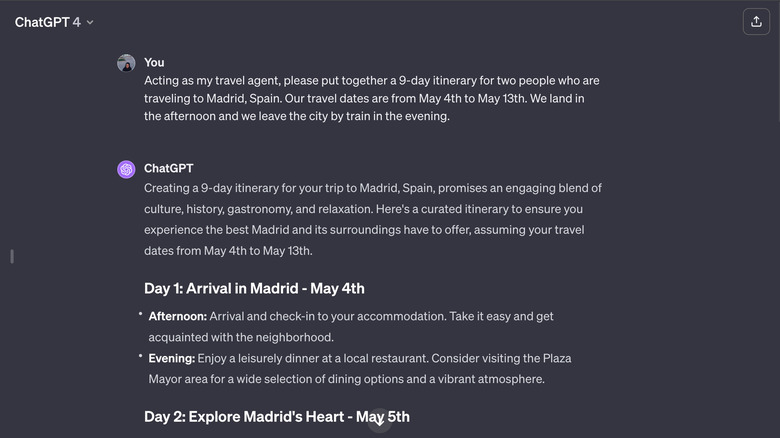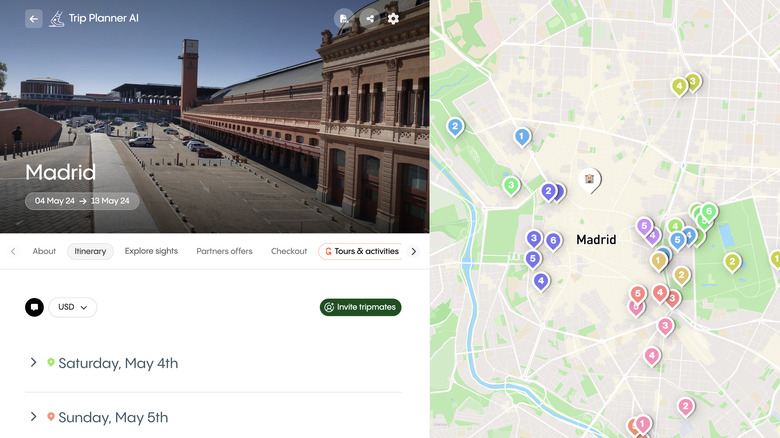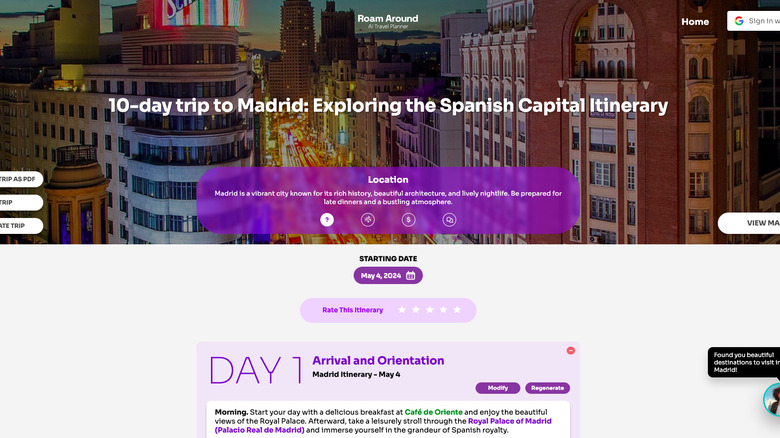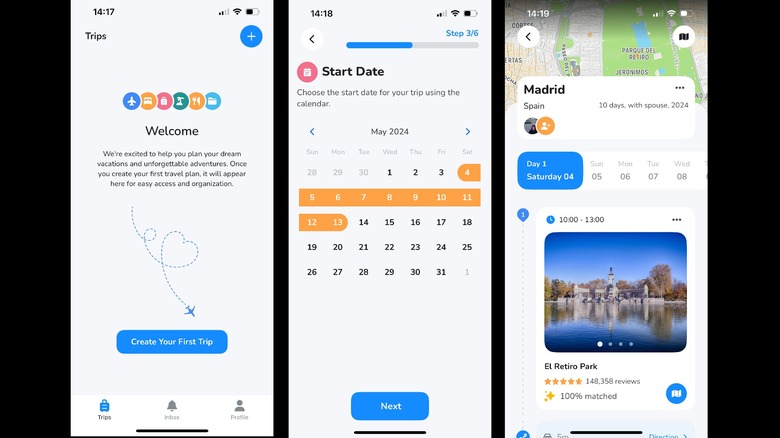We Let AI Plan Our Vacation And Here's How It Went
The future is now — and AI is here to transform it. From helping you find information to making decisions, optimizing workflows, and even personalizing experiences, AI is reshaping pretty much every industry out there — from healthcare to marketing, software to retail, and education to travel. Because, whether you're directly involved in technology or not, efficiency (speed) and convenience (ease) have become more important than ever when it comes to helping us lead a more streamlined (impatient) lifestyle. And that's precisely where something like AI travel planners comes in.
Similar to what travel agents can do, AI travel planners create personalized travel itineraries and destination guides for you with just a few clicks. Simply choose your preferred platform — there are dozens — enter some key pieces of information like your destination, travel dates, and number of travelers, and let AI work its magic. And, while regular agencies might be lacking when it comes to immediate responses or certain customization capabilities, AI planners can put together a done-for-you plan in minutes — sometimes even less.
To see what all the buzz is about, we decided to put some of the most popular AI travel planning tools to the test to help us plan an upcoming nine-day trip to Madrid, Spain. Armed with a very vague sense of what we wanted to do while in the city, we hopped online, did a quick Google search, and chose four different (and free!) platforms: ChatGPT, Trip Planner AI, Roam Around, and iPlan.ai.
ChatGPT
To kick things off, we headed over to good ol' ChatGPT. Although not technically an AI travel planner, ChatGPT uses previously learned information and advanced natural language processing (NLP) techniques that can generate travel itineraries. For our initial prompt, we provided the platform with very basic instructions — the number of people traveling, our destination, and our travel dates — and let it do the rest. Within a couple of seconds, ChatGPT-4 had written out a day-by-day itinerary that also included generic tips like "Take it easy and get acquainted with the neighborhood."
Since the initial response felt a little bland, we went ahead and provided the platform with additional details like the name of the neighborhood we're staying in, and asked it to be more specific about which attractions, restaurants, and shops to visit. With the updated prompt, ChatGPT provided a more detailed itinerary that included names but was still missing addresses and distances. This meant we had to, once again, prompt the platform in order to get what we were looking for. The constant back and forth with ChatGPT took less than 10 minutes until it created an itinerary we were relatively happy with.
Overall, ChatGPT worked great as a base from which we could build a more detailed and personalized itinerary for ourselves. However, since the platform is mostly text-based, it was difficult for us to get a sense of exactly where it was sending us, what it recommended, and how the trip might actually look.
Trip Planner AI
First on the list of dedicated AI travel planners was Trip Planner AI. Founded in 2023, the site lets you create itineraries, book tours, and purchase tickets — all from within the same interface. Once you've created an account, all you need to do is provide them with details on your destination, travel dates, number of people traveling, average budget, interests, and even how busy you want your schedule to be. Once the platform has compiled all of this information, it'll throw out an itinerary — complete with a color-coded map — in just seconds.
Along with the map, Trip Planner AI's itinerary also includes the attractions' distance from your accommodation — and from one another — as well as short descriptions of each place, average prices and entrance fees, and even potential time slots for your visit. It even throws out an estimate for how much you'll spend that day on food and other touristy things — which makes it a great tool if you have a strict budget!
In terms of details, Trip Planner AI had a lot more to offer than ChatGPT. However, we weren't too happy with some of the results that the platform kept giving us. Specifically, some of the restaurants and cafés in the itinerary seemed to have been picked solely based on proximity and not quality or reputation. Additionally, we also couldn't find a way to edit our itinerary, which meant we had to keep creating new ones if we wanted to see different options.
Roam Around
Next, we hit up Roam Around. After signing into the platform with your Google account, all you need to do is simply input your destination and travel dates, and the platform will quickly put together a multi-day itinerary for you. Broken up into morning, afternoon, evening, and bedtime, it covers everything from where to eat to what to see, where to shop, and where to go from some sundown drinks.
Additionally, the platform also collaborates with Viator and Get Your Guide — two of the most popular travel apps for finding experiences — so you can book admission tickets and tours directly from them. Other features include a handy "regenerate" button, which shuffles up your day or trip if you're not happy with what the platform churned out, an interactive map that pinpoints everything on your schedule, the option to add more days or check out other itineraries for nearby destinations, and a button that downloads your itinerary as a PDF.
One of the best things about Roam Around is that the destinations and attractions it picked felt a lot more curated and authentic than before. While the platform doesn't give you the opportunity to specify what you're into, it does a good job of providing a mix of cultural, outdoor, and leisure activities that most travelers will enjoy. Additionally, when it came to the recommended restaurants and bars, Roam Around's picks felt a little more thoughtful than Trip Planner AI's — sharing recommendations with higher reviews, better photos, and more detailed descriptions.
iPlan.ai
Lastly, we tried iPlan.ai. Unlike the others, the platform is solely available as a mobile app, which means you actually have to download it to your phone. And, even though we see the benefits of having your itinerary right in your pocket, it felt a little annoying that we needed to go through the hassle. Once you've downloaded the app, you can sign in with your Google account and start filling out your trip details.
Similarly to the sites before it, iPlan.ai will create a tailor-made itinerary for you based on your destination, travel dates, budget, and interests. Along with a list of attractions to see, the platform also includes estimated travel times between each spot, as well as detailed descriptions, operating hours, and reviews. Additionally, once you tap into each individual activity, the app is also designed to let you book tours and tickets by redirecting you to the Get Your Guide website.
In terms of convenience, iPlan.ai is a great tool to have during your trip. The interface connects to Google Maps, which means that you can easily access driving or walking directions to where you want to go. Ultimately, however, iPlan.ai didn't do much more than its web-friendly counterparts, and still had some debatable options when it came to dining.
Should you be using AI to plan your trips?
Overall, AI travel planners do exactly what they're meant to do: create full travel itineraries you can use. Whether or not this is enough to actually plan a trip is a different story. Why's that? Well, in terms of travel, some of the basic information provided by AI might be off because it just doesn't have access to real-time data.
The same goes for things like tickets and reservations. So while AI might be quick to recommend a famous landmark for a specific date, it won't be as quick to tell you that tickets have been sold out weeks in advance. Whether it's due to outdated information or operational changes, it's important to take everything with a grain of salt — and, ideally, double or even triple-check the source yourself.
All in all, we felt like the AI travel planners we chose did a good job with their itinerary-making. Most of them even chose the same attractions — sometimes on the same days — which probably means they're drawing from similar datasets. However, there was a clear winner in terms of usability, user experience, and detail, and that was: drum roll, please... Roam Around! Simple to use and intuitive, the platform gave us exactly what we wanted without the need to fill out too much personal information or navigate through complex interfaces. Plus, the site's own chatbot, Layla, is also a great source of more specific-detail information when you need it.





